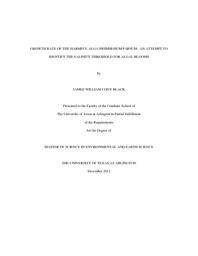
ATTENTION: The works hosted here are being migrated to a new repository that will consolidate resources, improve discoverability, and better show UTA's research impact on the global community. We will update authors as the migration progresses. Please see MavMatrix for more information.
Show simple item record
| dc.contributor.author | Black, James William Cody | en_US |
| dc.date.accessioned | 2013-03-20T19:12:16Z | |
| dc.date.available | 2013-03-20T19:12:16Z | |
| dc.date.issued | 2013-03-20 | |
| dc.date.submitted | January 2012 | en_US |
| dc.identifier.other | DISS-11917 | en_US |
| dc.identifier.uri | http://hdl.handle.net/10106/11591 | |
| dc.description.abstract | Harmful algal blooms due to Prymnesium parvum have occurred in Texas for nearly three decades in waters of moderate salinity. More recently, blooms have occurred in locations such as West Virginia, in waters of very low salinity where pollution discharges are suspected to have increased salinity to levels that support growth of P. parvum. These observations raise the question, what is the lowest salinity at which this species of algae can cause toxic fish kills? Previous research based on field observations has suggested a salinity threshold of about 1.5 PSU for occurrence of blooms in Texas reservoirs in winter. Other research using laboratory cultures suggest that temperature influences the growth response of P. parvum to salinity. Here we use laboratory cultures to attempt to identify the threshold salinity for blooms of this harmful species. We used 12-hour day/night cycles at temperatures of 10¡ã C and 20¡ã C with a range from 0.6 to 5.8 PSU. Population growth of cultures was measured over periods of 1, 2, 3, and 4 weeks. At 10¡ã C, average population growth rates over longer time scales of 21 to 28 days were positive only at 5.8 PSU, but shorter time scales positive growth was observed at 2.0 PSU. At 20¡ã C positive growth at time scales of 21 to 28 days was produced at 2.0, 2.5 and 5.8 PSU, and at shorter time scales positive growth occurred at salinities as low as 0.6 PSU. A regression analysis indicated that growth may be possible at salinities ranging as low as 1.0 PSU. Previous laboratory studies have measured growth over shorter time scales, and predictive regression models from those studies were evaluated with data obtained here. These results suggest that models based on such short term measurements might not predict growth very well over longer time intervals. In contrast, the salinity thresholds for positive growth estimated here, of 1.0 to 1.5 at 20¡ã C and 2.2 to ¡Ö 3.1 PSU at 10¡ã C, are similar to those estimated from field observations. | en_US |
| dc.description.sponsorship | Grover, James P. | en_US |
| dc.language.iso | en | en_US |
| dc.publisher | Environmental & Earth Science | en_US |
| dc.title | Growth Rates Of The Harmful Alga Prymnesium parvum: An Attempt To Identify The Salinity Threshold For Algal Blooms | en_US |
| dc.type | M.S. | en_US |
| dc.contributor.committeeChair | Grover, James P. | en_US |
| dc.degree.department | Environmental & Earth Science | en_US |
| dc.degree.discipline | Environmental & Earth Science | en_US |
| dc.degree.grantor | University of Texas at Arlington | en_US |
| dc.degree.level | masters | en_US |
| dc.degree.name | M.S. | en_US |
Files in this item
- Name:
- Black_uta_2502M_11917.pdf
- Size:
- 528.2Kb
- Format:
- PDF
This item appears in the following Collection(s)
Show simple item record


